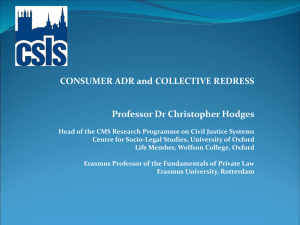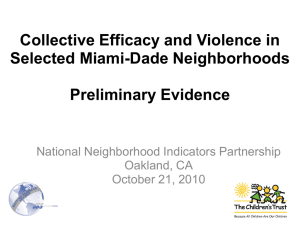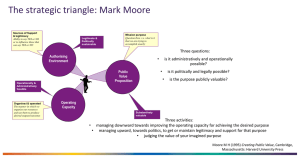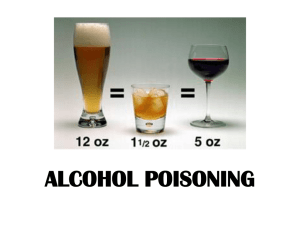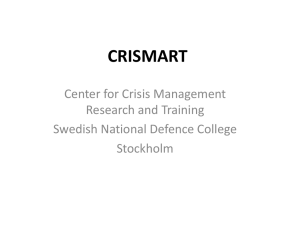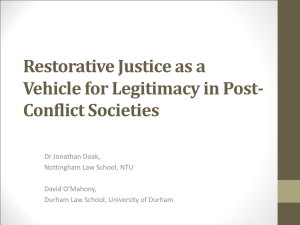Community Involvement PPT
advertisement
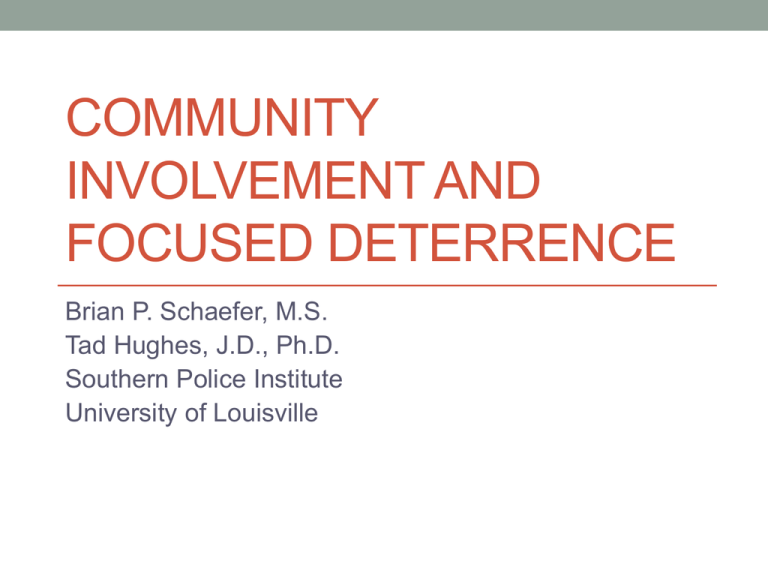
COMMUNITY INVOLVEMENT AND FOCUSED DETERRENCE Brian P. Schaefer, M.S. Tad Hughes, J.D., Ph.D. Southern Police Institute University of Louisville Focused Deterrence • Started with Boston’s Operation Ceasefire in mid-1990s • Applied in multiple jurisdictions • Boston, MA; Cincinnati, OH; Lowell, MA; High Point, NC; Kansas City, MO; Louisville, KY • Strategy has led to a 22 to 60 percent reduction in homicides across jurisdictions. Focused Deterrence • Key elements: • Identify crime problem • Problem-oriented Policing • Create interagency working group • Generate consistent enforcement • Identify violent offenders and groups • Specific and general deterrence • Develop enforcement strategies to reduce crime • Increase in certainty and severity • Enlist community and social services • Informal sanctions • Communicate new rules • Cost cannot be considered unless it is known The role of the Community in Pulling Levers • Improving the health of communities • Informal social control • Collective Efficacy • Improving community and criminal justice collaboration • Police Legitimacy Collective Efficacy • Collective efficacy is the process of activating or converting social ties to achieve desired outcomes. • Collective efficacy is a dynamic factor. • Communities with weak collective efficacy lack the closeness and trust—sometimes called social capital—to mobilize as a group and rid their street of troublemakers and disorder. • Benefits (Eck and Rosenbaum, 1994): • Improve police-community relations • Increase legitimacy of police operations • Reduce fear • Decrease crime and Disorder Legitimacy • Procedural justice suggests that perceptions of fairness matter more than the outcomes (Tyler, 1988, 2000). • This notion holds whether the situation is negotiations, punishments, or reward distribution (Lind & Tyler, 1988). Three primary process-based evaluations: • Quality of decision making • Quality of treatment • Trustworthiness. • Transparency is key for legitimacy (Tyler & Wakslak, 2004) Hurdles to Engaging the Community • What is the community? • Disengagement • Racial History What is the community? • Kennedy (2011) talks about 3 communities: • Law enforcement • The community in poorest neighborhoods • The community of offenders • Racial animosity in poor communities • History of racial oppression • Racial Profiling Disengagement • Disengagement • Communication between community participants and police is nonexistent, adversarial, and/or one-way • Informed and committed local and police leadership may not exist. • There is a lack of community organizations through which neighborhood residents can participate • Sometimes there are organizations, but the leadership is not well informed. • Sometimes the only community-based organizations that exist are concerned with serving clients not in solving community problems. • Community residents may feel that their neighborhood is lost and they are powerless. Building Effective Community Groups • Know your problem • Identify what you intend to accomplish • Identify Stakeholders • What parties need to be involved? • Secure Commitments from participating parties • Community Teambuilding • Clearly identify the extent of the collaboration and its benefits • Identify resources you will need • Develop tasks and a corresponding timeline • Be clear about the roles and responsibilities of group members • Evaluate • Quick Wins (Tilley, 1999) Potential Strategies for The community in Pulling Levers Strategy • Call-Ins • Moral Voices • Street workers • Community Accountability Boards Call-Ins: Several Approaches • Formal Call-Ins • Focuses on reaching out to gangs and community groups and attempting to change their behavior. • Community Call-Ins • Informal discussions • Focused on community aspects rather than law enforcement consequences • Homes Visits • Associated with drug-market interventions. • Using “Influentials” Community as Moral Voice • Common themes in call-ins (Kennedy, 2010): • All of us would like to change • All parties respect you • There is no justification for the violence • The community needs the violence to stop • Ideas of the street code are wrong • Law enforcement, social services, and the community have been part of the problem • You are valuable to the community Street workers • Serve as a community representative for project. • Focused on outreach activities related to violence interruption, mediation, and spreading non-violence messages to the community. • Potential Issues: • High turnover • Inadequate training • Criminal activity Community Accountability Boards (CAB) • Serves as an alternative to the traditional criminal justice responses and focuses on providing victims (individuals and community members) a voice in repairing the harm caused by crime. • The CAB is made of community members. • Goal is for offenders to understand the harm they cause. • Primarily used for misdemeanor offenders. Pulling Levers and CAB • Community Accountability Boards provide the Moral Voice • Centralized community and government collaboration that can provide long-term assistance independent on law enforcement strategies. • Building legitimacy through collective response to crime. • Leveraging the legitimacy for future participation CAB and Pulling Levers Overview
